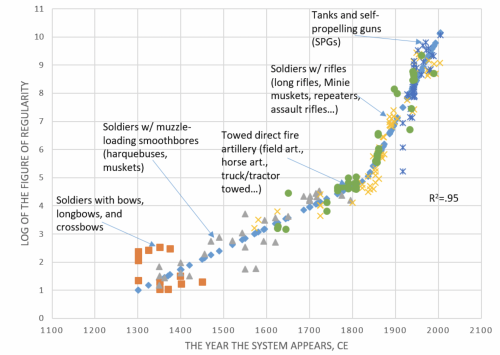In 2017, I wrote a post documenting the increasing frequency and overall lethality of mass shootings in the United States. Since then, there have been many mass shootings, although none with a death toll exceeding that of the Las Vegas massacre. I concluded that at some point, increases in these events would be incompatible with the continuation of ordinary civic life.
Life in cities — and civilian life generally — involves people gathering in public spaces. At some point, continued increases in the frequency and scale of mass shootings become incompatible with ordinary civic life.
I don’t have a complete explanation for this trend of increasing massacres. But one factor – there are undoubtedly many others – is the improvement of firearms technology.
A recent paper by Alexander Kott, a US Army researcher, describes the increase in the lethality of military technology since 1300 CE. Military technology is relevant because civilian arms derive from military weapons. Here is the key graph.

The vertical axis is hard to explain, so please bear with me. It is the logarithm of the ‘Figure of Regularity’ (FoR). Ignore the log scale for a moment and forgive the author the awkward name. What Kott wants to do is to develop a single metric that will allow him to compare the effectiveness of diverse weapon systems for land warfare.
The FoR is empirically-derived. However, Kott suggests that for infantry weapons, FoR is proportional to the kinetic energy (KE) of the projectiles that a weapons system fires per second per unit of mass of the overall system. So, think of the vertical-axis units as KE * rounds/second/kg. KE is one-half the projectile mass times the velocity squared. An AR-15 fires a 4-gram bullet at 990 m/s, for a KE of about 1900 joules. Imagine a 15-pound dumbbell hitting you at 60 mph.
The normalization by the mass of the weapon system makes different weapons comparable. That is, compared to an assault rifle, a machine gun fires a round with higher KE at a much higher rate. But a machine gun also weighs more than a rifle, requires constant resupply of ammunition, and needs to be transported and served by a crew. Intuitively, an army needs a mixture of tanks, artillery, and small arms. The FoR suggests that, as economic theory would predict,* during any given historical epoch the returns on investments in different weapon systems are roughly comparable.
Kott’s graph shows that the FoR of land warfare weapon systems increases each century. In 2019, a single man can walk into a church and slaughter dozens of people in seconds. Not even the most skilled bowman could do that in 1319. But now recall that the graph plots log(FoR). This means that what the graph shows is that FoR grows exponentially. Also, the growth in FoR accelerates starting in the first half of the 19th century. Kott’s data suggest that in the modern era, KE * rounds/second/kg doubles every thirty years.
Therefore, don’t just ask yourself whether you can tolerate the state of gun violence today. Ask yourself whether you will be able to tolerate it in the future. For many readers of this post, weapons lethality will double in your lifetime. For some of you, it will double twice.
Doubtlessly, the parameters describing the growth in FoR for civilian arms are different from the military weapons studied by Kott. What matters for my argument, though, is the functional form of the growth in the lethality of civilian arms. Many gun owners crave military weapons and civilian arms makers copy military weaponry as nearly as they are allowed to. I see little reason to believe that the historical growth in the lethality of civilian arms is less than exponential.
There is a fabric of civil life on which we all depend. We need public spaces where we can shop, travel, pursue education, enjoy the arts, celebrate holidays, participate in discussions, and worship with neighbours and strangers. The spaces where we join others to enjoy and support these cultural foundations need to be safe. Now think about Las Vegas or Parkland. And double them. If we cannot participate in public events in person, we will lose much of our civil life.
Unless, somehow, we can limit the firepower of civilian arms.
*In this context, I can’t help but quote Carlyle about economics:
Not a “gay science”, I should say, like some we have heard of; no, a dreary, desolate and, indeed, quite abject and distressing one; what we might call, by way of eminence, the dismal science.
